|
|
|
|
|
|
|
Achi-Kochi Japan
Showing many places to visit and foods to eat in Japan
|
|
|
|
|
|
|
|
|
|
|
|
|
Japan
> Themes
> Castles
|
|
|
|
|
|
|
Castles
( Achi-Kochi Japan )
|
|
|
|
|
|
|
|
|
|
|
|
|
( "Achi-Kochi" in Japanese means "Here and there" in English. )
More Than 25 Thousands of Castles
More than 25 thousands of castles have been built in Japan for a few thousand years since the Formation of Japan through Samurai Age. In the 19th century, there remained a few hundred castles, among which many were demolishes in Meiji Period after Tokugawa Shogunate was overthrown in A.D.1868. In WWII, some castles were burnt down by air raids.
There are many sites of castles, among which twelve main keeps remain extant. In addition, a certain numbers of castles have been reconstructed with reinforced concrete. This page shows castles which are famous, beautiful and/or popular among tourists.
|
Himeji-jo Castle
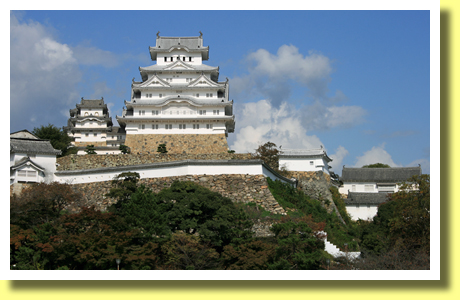
Himeji-jo Castle ( above ), located in Himeji City, Hyogo Pref., Kinki Region, is one of the most beautiful, famous and popular castles in Japan. Its main keep has been overlooking the city since A.D.1609. The castle is one of designated National Treasures of Japan and one of UNESCO World Heritage sites.
On 3rd July 1945, more than one hundred aircrafts flew over the city to drop several hundred tons of bomb, which destroyed lots of buildings but Himeji-jo Castle survived miraculously. The castle is also called Shirasagi-jo. "Shirasagi" in Japanese means "white heron" in English.
|
Matsumoto-jo Castle
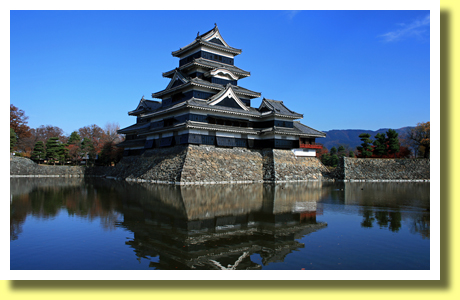
Matsumoto-jo Castle ( above ), located in Matsumoto City, Nagano Pref., Koh-Shin-Etsu Region, is another one of the most beautiful, famous and popular castles in Japan. Matsumoto-jo Castle, built in A.D.1594 or so, is the oldest among remaining castles and is one of the five castles designated as National Treasures in Japan.
It is not easy to walk up stairs in the six-story main keep of Matsumoto-jo. The stairs are so narrow and steep. In Sengoku Jidai ( the Age of Warring States ) when the castle was built, it should not be easy for intruders to walk up stairs. The top floor of the castle offers fine views of mountains of Japanese Alps and Matsumoto City as well as moats surrouding the castle.
|
Edo-jo Castle
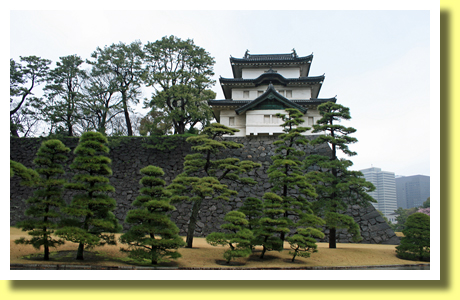
Ieyasu Tokugawa moved to Edo ( Tokyo now ) in A.D.1590 and enlarged old Edo-jo Castle. He established Tokugawa Shogunate in A.D.1603. In the site of Edo-jo, a huge main keep was built three times. However the main keep was destroyed in the fire in A.D.1657. Since then on, Fujimi-yagura ( above ), a three story keep, has served a function of the main keep.
Tokugawa Shogunate was overthrown in A.D.1868 and Edo-jo Castle became Kokyo ( The Imperial Palace ), some areas of which are open to public. However access to most of the important structures of Kokyo is strictly limited. Visitors could join guided tours under a certain conditions to go deeper into Kokyo.
For further details ==>
The Imperial Household Agency ( English )
|
Inuyama-jo Castle

Inuyama-jo Castle is located in Inuyama City, Aichi Pref., Tokai Region. The main keep ( above ) of the castle was built in A.D.1537 and renovated in A.D.1596. The main keep, not so big, is designated as one of the National Treasures of Japan. The site of the castle is designated as a National Historic Site.
The main keep stands on the top of small mountain ( 88 meters high ). So to see the main keep, visitors walk up the stone paved path, lined with old stone walls. The top level of the main keep offers a fine view. The castle, rich in cherry trees, is popular, especially in the season of Hanami ( Sakura Viewing ).
|
Hirosaki-jo Castle

Hirosaki-jo Castle, located in Hirosaki City, Aomori Pref., Tohoku Region, was built in A.D.1611. The 1st main keep of the castle was burnt down and the 2nd main keep ( above ), built in A.D.1810 remains as well as some gates, turrets, stone walls and moats.
Several structures including the main keep are designated as National Important Cultural Properties of Japan and the site of the castle is designated National Historic Site. There are a few thousands of cherry trees around the castle and the Cherry Blossom Festival is held in early May. So many tourists visit the castle, especially in the season of Hanami ( Sakura Viewing ).
|
Goryokaku Fortress
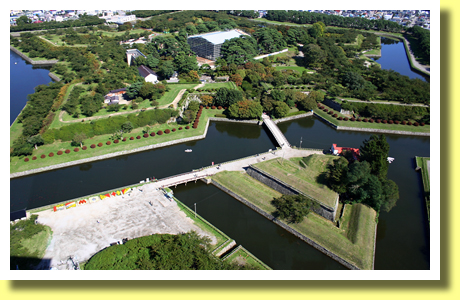
Goryokaku Fortress ( above ), located in Hakodate City, Hokkaido, has a form like a five-pointed star. Its name "Goryokaku" in Japanese means "five-point structure" in English. Goryokaku Fortress was built in French style by Tokugawa Shogunate in A.D.1866 for national defence against invasions by foreign armies.
In A.D.1868, Tokugawa Shogunate was overthrown. However thousands of Tokugawa vassals refused to obey Meiji Government and occupied Goryokaku Fortress. Meiji Government sent the Imperial Forces to Hakodate. The rebels surrendered in A.D.1869. Now Goryokaku Tower stands beside the fortress and helps tourists overlook Goryokaku Fortress.
|
Osaka-jo Castle

Osaka-jo, located in Osaka City, Osaka Pref., Kinki Region, is one of the most popular castles in Japan. The main keep of the castle was burnt down in A.D.1665 and in A.D.1931, the new main keep ( above ) was rebuilt with reinforced concrete.
The construction of Osaka-jo Castle was started in A.D.1583 by Hideyoshi Toyotomi, who is one of the most popular warlords in Japan. He unified Japan and ended the Sengoku Jidai ( the Age of Warring States ). Osaka bacame the center of Japan then.
There is the Osaka Museum of History beside the castle. From the top floor of the museum, tourists could overlook Osaka-jo Castle as well as the exhibits relating to Osaka are interesting.
|
Hiroshima-jo Castle
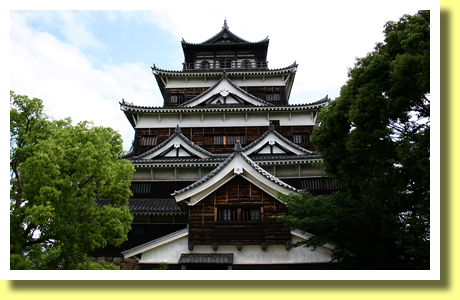
Hiroshima-jo Castle is located in Hiroshima City, Hiroshima Pref., Chugoku Region. As known, the first atomic bomb was dropped over Hiroshima and exploded at 08:15am on 06th August 1945. It killed about 140,000 people and destroyed lots of buildings including Hiroshima-jo Castle, of which the main keep ( above ) was reconstructed in A.D.1958. Many tourists visit Hiroshima Peace Memorial Museum and Atomic Bomb Dome in Hiroshima.
|
Matsuyama-jo Castle

Matsuyama City, Ehime Pref., Shikoku Region is famous for Dogo Onsen hot springs. Also many tourists visit Matsuyama-jo Castle ( above ), which was constructed in the early 17th century. However the main keep was burnt down by lightning in A.D.1784. Now visitors could see the main keep which was built in A.D.1854.
The main keep stands on the top of the mountain ( 132 meter-high ). On the top of the main keep, tourists could overlook the site of the castle and Matsuyama City. Also visitors could walk inside the main keep complex, where swords, armour and many more related to the history of the castle and the city are exhibited.
The main keep is surrounded by many cherry trees. So many people visit the castle especially in the season of Hanami ( Sakura Viewing ).
|
Kochi-jo Castle
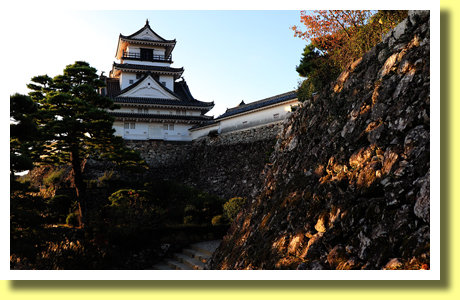
Kochi-jo Castle ( above ), located in Kochi City, Kochi Pref., Shikoku Region, is one of
the twelve castles whose main keeps remain extant. In addition, Kochi-jo is only one castle where not only main keep but also its castle palace remain in the site. Visitors could walk inside the main keep and the palace where feudal lords of Tosa ( now Kochi Pref. ) had resided.
The original buildings of Kochi-jo Castle were constructed in the early 17th century. But most of them were burnt down in A.D.1727. The reconstruction was completed in A.D.1753. Now more than a dozen of structures of the castle are designated National Important Cultural Properties of Japan. In addition, the castle is famous for Hanami ( Sakura Viewing ).
|
Kumamoto-jo Castle
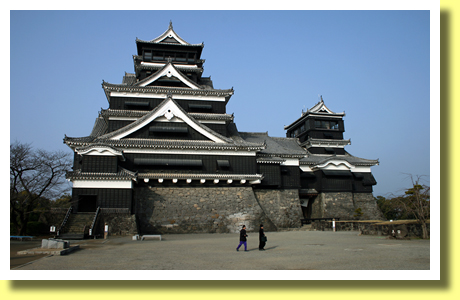
Kiyomasa Kato became the feudal lord of Kumamoto Domain in A.D.1588. He was a famous warlord known for the skills in designing castles and started the construction of his own castle, Kumamoto-jo Castle ( above ), in Kumamoto City, Kumamoto Pref., Kyushu Region. It was one of the strongest castles in Japan at the time and now it is one of the most popular castles.
However, the castle was involved in the Seinan Civil War in A.D.1877 and the main keep was burnt down. It was in A.D.1960 that the main keep was reconstructed with reinforced concrete.
In A.D.2016, Kumamoto City and surrounding areas were attacked by strong earthquakes and Kumamoto-jo Castle was heavily damaged. Soon the restoration started, which is scheduled to be completed in A.D.2036. At this moment, visitors could walk some elevated walkways to view the castle and enter the main keep.
|
Shuri-jo Castle

For several centuries, Shuri-jo Castle had been the centre of Ryukyu Kingdom, which was replaced with Okinawa Prefecture by Japanese government in A.D.1879. The most of the buildings were destroyed in the battle in A.D.1945 at the end of WWII and Seiden ( Main Hall - above right ) , Hokuden ( North Hall - above left ) and more buildings of the castle were reconstructed in A.D.1992.
In October 2019, Seiden, Hokuden and Nanden ( South Hall ) and a few more buildings of Shuri-jo Castle were burnt down by a fire, before which the above photo was taken. The reconstruction of the castle, a symbol of the history of Okinawa, has started and it is scheduled to be completed in A.D.2026.
At this moment, visitors could see the reconstruction works and the some structures including gates and stone walls as well as fine views overlooking Naha City. The site of the castle is a part of a UNESCO World Heritage Site.
|
Copyright (c) 2021 Achi-Kochi Zanmai Co., Ltd.
|